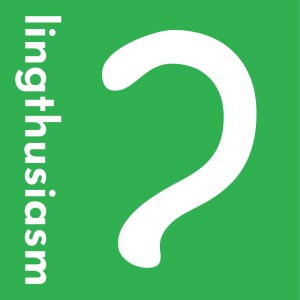
Say, “aaaaaahhhh…..” Now try going smoothly from one vowel to another, without pausing: “aaaaaaaeeeeeeeiiiiiii”. Feel how your tongue moves in relation to the back of the roof of your mouth as you move from one vowel to the next. When you say “ahhhh” like at the dentist, your tongue is low and far back and your mouth is all the way open. If you say “cheeeeese” like in a photo, your tongue is higher up and further forward, and your mouth is more closed: it’s a lot harder for the dentist to see your molars.
In this episode, your hosts Lauren Gawne and Gretchen McCulloch explain how the position of our tongue when we make vowels can be described in the shape of a trapezoid: it can go up and down, forward towards the teeth and backwards towards the throat, and there’s a bit more space for movement higher up towards the roof of your mouth.
Vowels don’t just exist in a trapezoid, they move around inside it: sometimes they squish up against their neighbours, sometimes they expand into less-occupied corners of the trapezoid for more elbow room. These vowel gymnastics explain so many things: why is the first letter in the alphabet named “ay” in English, but “ah” in most other languages that use the Roman alphabet? Why is “e” in “coffee” pronounced one way and “cafe” another, when they’re clearly related? Why is English spelling so difficult? What’s the difference between a California accent and a Kiwi accent?
This month’s Patreon bonus episode is about constructing languages for fun and learning. To listen to bonus episodes and support the show, visit patreon.com/lingthusiasm.
To see this episode's shownotes, including how to run your own wug test and lots of fun wug creations, visit http://lingthusiasm.com/post/170920044226/lingthusiasm-episode-17-vowel-gymnastics-say
view more
More Episodes
37: Smell words, both real and invented
 2019-10-17
2019-10-17
 2019-10-17
2019-10-17
34: Emoji are Gesture Because Internet
 2019-07-18
2019-07-18
 2019-07-18
2019-07-18
30: Why do we gesture when we talk?
 2019-03-21
2019-03-21
 2019-03-21
2019-03-21
25: Every word is a real word
 2018-10-18
2018-10-18
 2018-10-18
2018-10-18
23: When nothing means something
 2018-08-16
2018-08-16
 2018-08-16
2018-08-16
19: Sentences with baggage - Presuppositions
 2018-04-19
2018-04-19
 2018-04-19
2018-04-19
18: Translating the untranslatable
 2018-03-15
2018-03-15
 2018-03-15
2018-03-15
012345678910111213141516171819
Create your
podcast in
minutes
- Full-featured podcast site
- Unlimited storage and bandwidth
- Comprehensive podcast stats
- Distribute to Apple Podcasts, Spotify, and more
- Make money with your podcast
It is Free
- Privacy Policy
- Cookie Policy
- Terms of Use
- Consent Preferences
- Copyright © 2015-2024 Podbean.com






